Bird Houses
Please note that all of information provided on our website about our products is meant to be informative only. For more information regarding prices and shipping (within Canada only) please visit our store in Newmarket (16655 Yonge Street, Unit #2 Newmarket, ON), phone us (905) 868-9696 or send us an email at [email protected].
Bird houses, or nest boxes are used by a wide variety of birds that nest naturally in tree cavities. This includes birds such as wrens, chickadees, nuthatches, bluebirds, Purple Martins as well as some species of woodpeckers, swallows, flycatchers and owls. In addition to traditional style bird houses we also sell WBU Nesting Perches for species that typically nest on ledges such as American Robins, Easter Phoebes, Barn Swallows and Gray Catbirds. For the winter season we carry roosting boxes to help birds get some shelter and survive cold conditions. Bird houses should be placed out for use between February and March, so birds can inspect them.
WBU Bird House Features
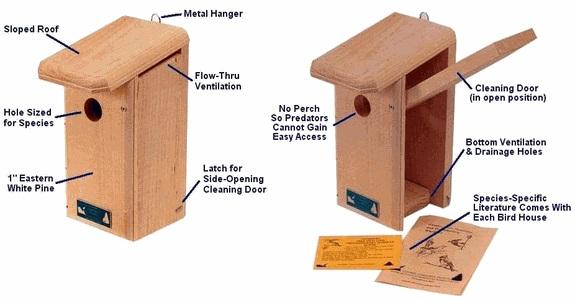
Eastern Bluebird Houses
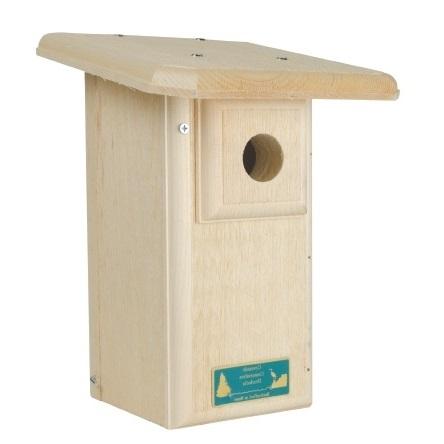 WBU Eastern Bluebird House: The WBU Eastern Bluebird House is one of the finest bluebird houses on the market! Predator guard is standard to keep starlings, squirrels and other undesirables out, while the small floor discourages sparrow nests. Made of Eastern White Pine this bird house is constructed to last and features ventilation and drainage holes, doors that open for easy access for cleaning, hooks for hanging and a rough interior so fledglings can easily leave the nest box. Each bird house also includes a brochure that describes the species that the nest box has been designed for, ideal placement, and maintenance of the product. This bird house has been approved by the North American Bluebird Society. This house can be mounted on the WBU Advanced Pole System® (APS) Basic Setup Mounting Hardware (sold separately) or a fence. Pole systems tend to offer the best protection from predators. Bluebird boxes should be mounted 4 to 5 feet above the ground and facing away from prevailing winds, and 50 to 100 meters apart. Try to place the boxes close to trees, shrubs, or fences. Bluebirds will use them when feeding and when young ones are learning to fly.
WBU Eastern Bluebird House: The WBU Eastern Bluebird House is one of the finest bluebird houses on the market! Predator guard is standard to keep starlings, squirrels and other undesirables out, while the small floor discourages sparrow nests. Made of Eastern White Pine this bird house is constructed to last and features ventilation and drainage holes, doors that open for easy access for cleaning, hooks for hanging and a rough interior so fledglings can easily leave the nest box. Each bird house also includes a brochure that describes the species that the nest box has been designed for, ideal placement, and maintenance of the product. This bird house has been approved by the North American Bluebird Society. This house can be mounted on the WBU Advanced Pole System® (APS) Basic Setup Mounting Hardware (sold separately) or a fence. Pole systems tend to offer the best protection from predators. Bluebird boxes should be mounted 4 to 5 feet above the ground and facing away from prevailing winds, and 50 to 100 meters apart. Try to place the boxes close to trees, shrubs, or fences. Bluebirds will use them when feeding and when young ones are learning to fly.
Dimensions: 12½" x 6" x 8½"
House Opening: 1½" diameter entrance hole
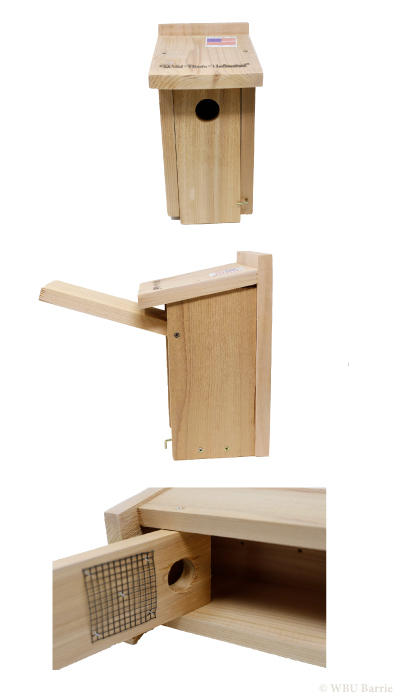 WBU Basic Bluebird House: The WBU Basic Bluebird House is simple yet functional. This house focuses on the basic needs of its intended residents Eastern Bluebirds. Made from cedar, this house features ventilation and drainage holes, doors that open for easy access for cleaning, hooks for hanging and interior ladder so fledglings can easily leave the nest box when the time comes. This bird house has been approved by the North American Bluebird Society. This house can be mounted on the WBU Advanced Pole System® (APS) Basic Setup Mounting Hardware (sold separately) or a fence. Pole systems tend to offer the best protection from predators. Bluebird boxes should be mounted 4 to 5 feet above the ground and facing away from prevailing winds, and 50 to 100 meters apart. Try to place the boxes close to trees, shrubs, or fences. Bluebirds will use them when feeding and when young ones are learning to fly.
WBU Basic Bluebird House: The WBU Basic Bluebird House is simple yet functional. This house focuses on the basic needs of its intended residents Eastern Bluebirds. Made from cedar, this house features ventilation and drainage holes, doors that open for easy access for cleaning, hooks for hanging and interior ladder so fledglings can easily leave the nest box when the time comes. This bird house has been approved by the North American Bluebird Society. This house can be mounted on the WBU Advanced Pole System® (APS) Basic Setup Mounting Hardware (sold separately) or a fence. Pole systems tend to offer the best protection from predators. Bluebird boxes should be mounted 4 to 5 feet above the ground and facing away from prevailing winds, and 50 to 100 meters apart. Try to place the boxes close to trees, shrubs, or fences. Bluebirds will use them when feeding and when young ones are learning to fly.
Dimensions: 12 H" x 6" W x 7¼” D
House Opening: 1½" diameter entrance hole
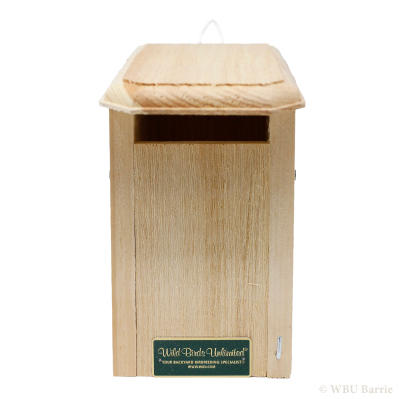 WBU Sparrow Resistant Bluebird Nest Box: Our WBU Sparrow Resistant Bluebird Nest Box is designed to thwart pesky sparrows from taking over the box. Made from cedar, this house features ventilation and drainage holes, a front door that opens for easy access for cleaning, hooks for hanging and a rough interior so fledglings can easily leave the nest box when the time comes. According to research at the University of Kentucky, bluebirds prefer a slot entrance to the standard circular hole – whereas sparrows prefer the opposite. In addition, the shallow depth of the box is disliked by sparrows, where bluebirds don't seem to mind. This box is only 5" deep but if sparrows continue to be a problem, a wooden insert is included to reduce the depth to only 3 ½”. Sparrows rarely use this depth, but bluebirds will still happily occupy it. This house can be mounted on the WBU Advanced Pole System® (APS) Basic Setup Mounting Hardware (sold separately) or a fence. Bluebird boxes should be mounted 4 to 5 feet above the ground and facing away from prevailing winds, and 50 to 100 meters apart. Try to place the boxes close to trees shrubs or fences. Bluebirds will use them when feeding and when young ones are learning to fly.
WBU Sparrow Resistant Bluebird Nest Box: Our WBU Sparrow Resistant Bluebird Nest Box is designed to thwart pesky sparrows from taking over the box. Made from cedar, this house features ventilation and drainage holes, a front door that opens for easy access for cleaning, hooks for hanging and a rough interior so fledglings can easily leave the nest box when the time comes. According to research at the University of Kentucky, bluebirds prefer a slot entrance to the standard circular hole – whereas sparrows prefer the opposite. In addition, the shallow depth of the box is disliked by sparrows, where bluebirds don't seem to mind. This box is only 5" deep but if sparrows continue to be a problem, a wooden insert is included to reduce the depth to only 3 ½”. Sparrows rarely use this depth, but bluebirds will still happily occupy it. This house can be mounted on the WBU Advanced Pole System® (APS) Basic Setup Mounting Hardware (sold separately) or a fence. Bluebird boxes should be mounted 4 to 5 feet above the ground and facing away from prevailing winds, and 50 to 100 meters apart. Try to place the boxes close to trees shrubs or fences. Bluebirds will use them when feeding and when young ones are learning to fly.
Dimensions: 10" H x 6" W x 8 1/2" D
![]() Add Me to your MyWBU Online Order - Include SKU #3040 in Your Order Notes at Checkout.
Add Me to your MyWBU Online Order - Include SKU #3040 in Your Order Notes at Checkout.
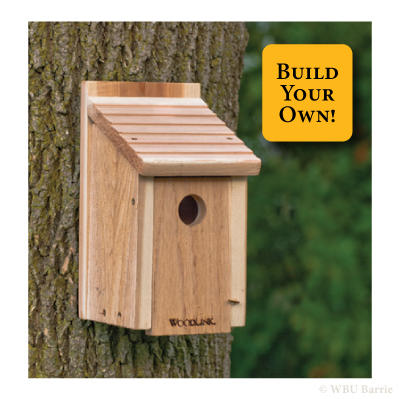 Bluebird House Kit for Kids: This Bluebird House Kit is a great way to get kids involved at an early age with both woodworking and enjoying nature. This build-it-yourself kit makes a great craft project for summer camps, Scout troops and fundraisers too! Easy to assemble and fun to build, all you need is a Phillips screwdriver and some imagination. Comes with stickers to decorate the house and a fun facts sheet to increase the educational aspect of the project. When complete, this house can be mounted on the WBU Advanced Pole System® (APS) Basic Setup Mounting Hardware (sold separately) or a fence. Pole systems tend to offer the best protection from predators. Bluebird boxes should be mounted 4 to 5 feet above the ground and facing away from prevailing winds, and 50 to 100 meters apart. Try to place the boxes close to trees shrubs or fences. Bluebirds will use them when feeding and when young ones are learning to fly. Made of Western Cedar components and includes proper ventilation for air circulation. Front door opens easily for annual cleaning. Appropriate for ages 5 and up.
Bluebird House Kit for Kids: This Bluebird House Kit is a great way to get kids involved at an early age with both woodworking and enjoying nature. This build-it-yourself kit makes a great craft project for summer camps, Scout troops and fundraisers too! Easy to assemble and fun to build, all you need is a Phillips screwdriver and some imagination. Comes with stickers to decorate the house and a fun facts sheet to increase the educational aspect of the project. When complete, this house can be mounted on the WBU Advanced Pole System® (APS) Basic Setup Mounting Hardware (sold separately) or a fence. Pole systems tend to offer the best protection from predators. Bluebird boxes should be mounted 4 to 5 feet above the ground and facing away from prevailing winds, and 50 to 100 meters apart. Try to place the boxes close to trees shrubs or fences. Bluebirds will use them when feeding and when young ones are learning to fly. Made of Western Cedar components and includes proper ventilation for air circulation. Front door opens easily for annual cleaning. Appropriate for ages 5 and up.
Finished House Dimensions: 7" D x 6.25" W x 11.75" H ( 17.7 cm x 15.8 cm x 29.8 cm)
House Opening: 1 9/16” diameter entrance hole
House Wren, Chickadee and Nuthatch Houses
House Wrens inhabit a wide variety of habitats and they readily take to nesting in bird houses (and just about anywhere else they can find). For House Wrens, houses should be mounted 5-10 feet high near trees or tall shrubs. House Wrens are quite sociable and will accept nest boxes close to your house. Wren houses should be mounted with the entrance hole away from prevailing winds on a tree, fence post, or on a pole like our WBU Advanced Pole System® (APS) Basic Setup Mounting Hardware (sold separately). Pole systems tend to offer the best protection from predators. It can also be hung using the WBU Hanging Cable.
Black-capped Chickadees are partial to nesting in shaded areas, forest edges, and meadows. For these birds, fill the box with 4-5 inches of wood shavings to allow them to excavate their own nest. Chickadee nest boxes should be mounted 5 to 15 feet above the ground with the entrance hole away from prevailing winds on a tree, fence post, or on a pole like our WBU Advanced Pole System® (APS) Basic Setup Mounting Hardware (sold separately). Pole systems tend to offer the best protection from predators. It can also be hung using the WBU Hanging Cable.
White-breasted Nuthatches prefer to nest near open areas, forest edges, and in open areas with large trees such as parks, wooded suburbs and yards. For nuthatches, bird houses are best hung 5-20 feet high in a tree away from buildings. Face the entrance hole away from prevailing winds and place about 1-2 inches of wood shavings on the bottom of the box.
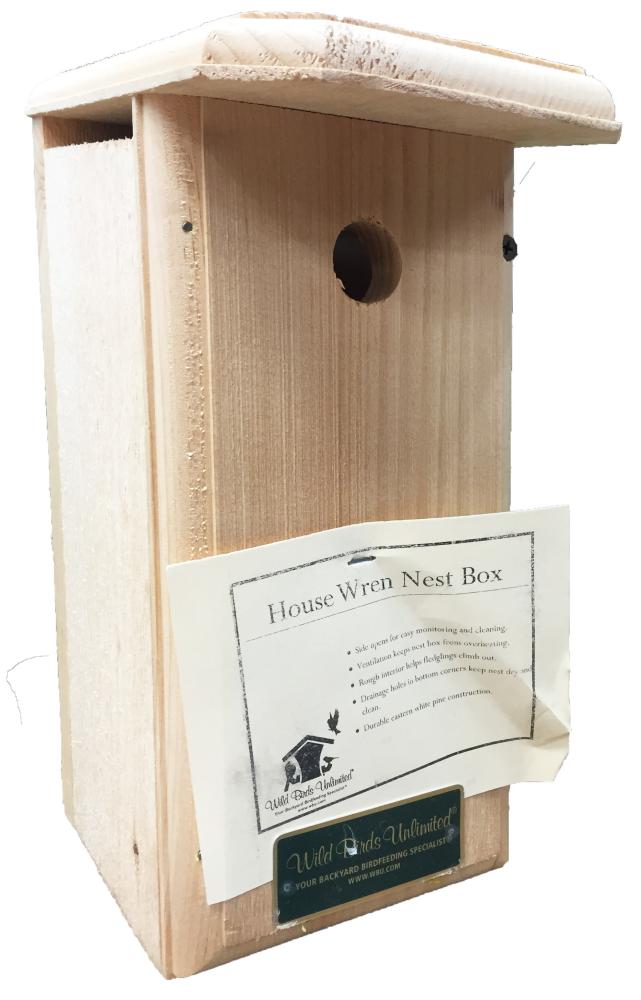 WBU House Wren House: With its 1" entrance hole, the WBU House Wren House provides great protection for house wrens. Wrens are very protective, so position the nest box in less frequented areas or you might get a scolding from a disgruntled parent. Made of Eastern White Pine, this bird house is constructed to last and features ventilation and drainage holes, doors that open for easy access for cleaning, hooks for hanging and a rough interior so fledglings can easily leave the nest box. Each bird house also includes a brochure that describes the species that the nest box has been designed for, ideal placement, and maintenance of the product.
WBU House Wren House: With its 1" entrance hole, the WBU House Wren House provides great protection for house wrens. Wrens are very protective, so position the nest box in less frequented areas or you might get a scolding from a disgruntled parent. Made of Eastern White Pine, this bird house is constructed to last and features ventilation and drainage holes, doors that open for easy access for cleaning, hooks for hanging and a rough interior so fledglings can easily leave the nest box. Each bird house also includes a brochure that describes the species that the nest box has been designed for, ideal placement, and maintenance of the product.
House Wrens inhabit a wide variety of habitats and they readily take to nesting in bird houses (and just about anywhere else they can find). For House Wrens, houses should be mounted 5-10 feet high near trees or tall shrubs. House Wrens are quite sociable and will accept nest boxes close to your house. Wren houses should be mounted with the entrance hole away from prevailing winds on a tree, fence post, or on a pole like our WBU Advanced Pole System® (APS) Basic Setup Mounting Hardware (sold separately). Pole systems tend to offer the best protection from predators.
Dimensions: 12½" x 6" x 8½"
House Opening: 1” diameter entrance hole
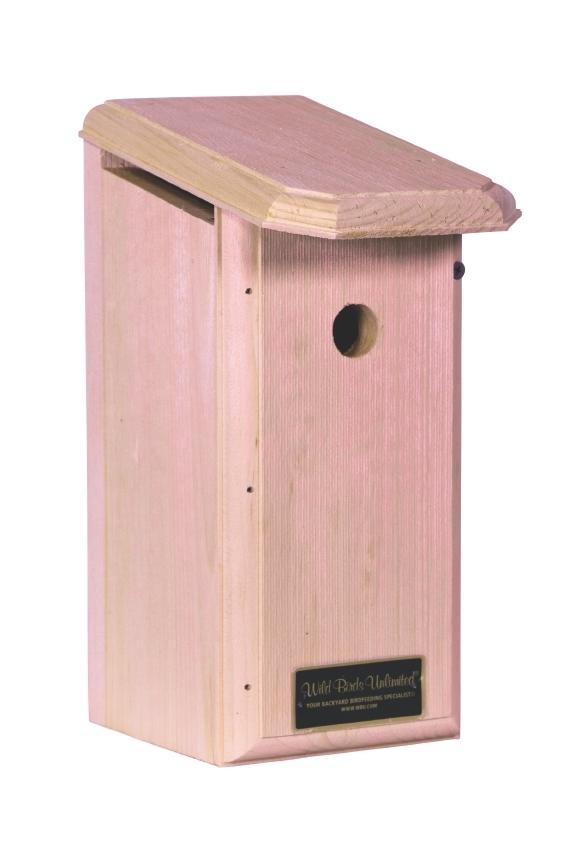 WBU Chickadee House: The WBU Chickadee House is properly sized to shelter one of America's favorite backyard birds. Made of Eastern White Pine, this bird house is constructed to last and features ventilation and drainage holes, doors that open for easy access for cleaning, hooks for hanging and a rough interior so fledglings can easily leave the nest box. Each bird house also includes a brochure that describes the species that the nest box has been designed for, ideal placement, and maintenance of the product. Black-capped Chickadees are partial to nesting in shaded areas, forest edges, and meadows. For these birds, fill the box with 4-5 inches of wood shavings to allow them to excavate their own nest. Chickadees nest boxes should be mounted 5 to 15 feet above the ground with the entrance hole away from prevailing winds on a tree, fence post, or on a pole like our WBU Advanced Pole System® (APS) Basic Setup Mounting Hardware (sold separately). Pole systems tend to offer the best protection from predators.
WBU Chickadee House: The WBU Chickadee House is properly sized to shelter one of America's favorite backyard birds. Made of Eastern White Pine, this bird house is constructed to last and features ventilation and drainage holes, doors that open for easy access for cleaning, hooks for hanging and a rough interior so fledglings can easily leave the nest box. Each bird house also includes a brochure that describes the species that the nest box has been designed for, ideal placement, and maintenance of the product. Black-capped Chickadees are partial to nesting in shaded areas, forest edges, and meadows. For these birds, fill the box with 4-5 inches of wood shavings to allow them to excavate their own nest. Chickadees nest boxes should be mounted 5 to 15 feet above the ground with the entrance hole away from prevailing winds on a tree, fence post, or on a pole like our WBU Advanced Pole System® (APS) Basic Setup Mounting Hardware (sold separately). Pole systems tend to offer the best protection from predators.
Dimensions: 12½" x 6"w x 8½"
House Opening: 1” diameter entrance hole
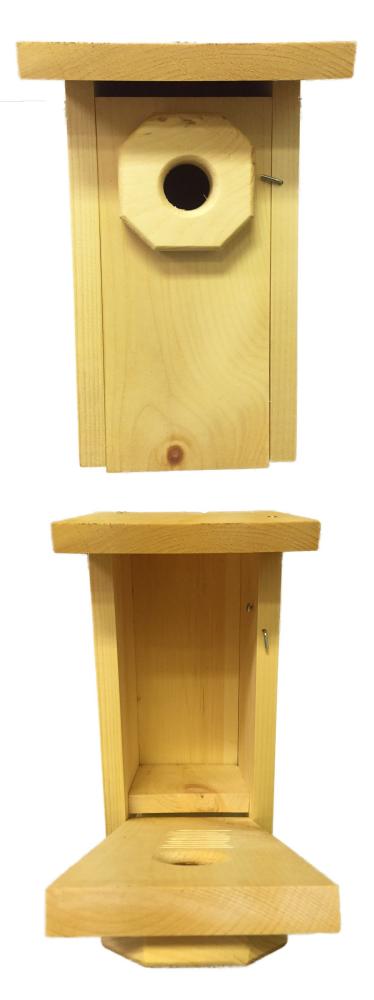 Chickadee/Nuthatch/Wren House: The Chickadee/Nuthatch/Wren House is a great choice for anyone looking to attract Black-capped Chickadees, White Breasted Nuthatches, or House Wrens into their outdoor space. Hand made here in Ontario from white pine and sealed with linseed oil, this house is ready to withstand the elements. The front wall opens to allow for easy cleaning and maintenance. The nesting needs of chickadees, nuthatches, and wrens are different and the placement of the nest varies depending on whom you want to attract. See descriptions above for more information on individual nesting habits, or contact us!
Chickadee/Nuthatch/Wren House: The Chickadee/Nuthatch/Wren House is a great choice for anyone looking to attract Black-capped Chickadees, White Breasted Nuthatches, or House Wrens into their outdoor space. Hand made here in Ontario from white pine and sealed with linseed oil, this house is ready to withstand the elements. The front wall opens to allow for easy cleaning and maintenance. The nesting needs of chickadees, nuthatches, and wrens are different and the placement of the nest varies depending on whom you want to attract. See descriptions above for more information on individual nesting habits, or contact us!
Dimensions: 14.5" H x 6" W x 7.5" D
House Opening: 1¼” diameter entrance hole
![]() Add Me to your MyWBU Online Order - Include SKU #430204 in Your Order Notes at Checkout.
Add Me to your MyWBU Online Order - Include SKU #430204 in Your Order Notes at Checkout.
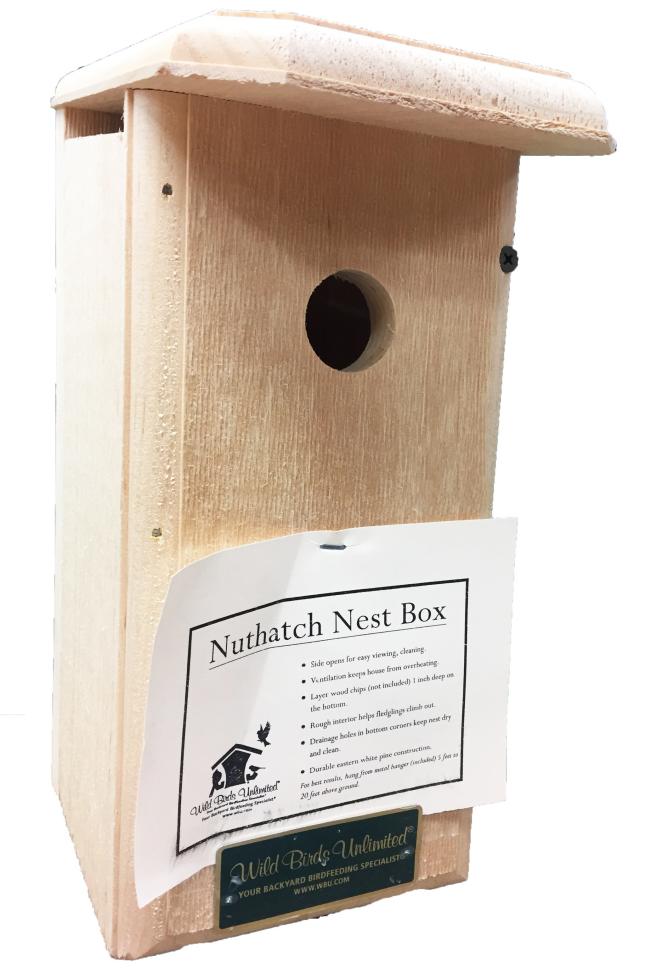 WBU Nuthatch House: Nuthatches are secondary cavity dwellers so they look for a nesting location that has already been established naturally or by another bird. Locate the WBU Nuthatch house away from buildings in a mature forest as best protection from house sparrows. This house accommodates both Red-breasted Nuthatches and White-breasted Nuthatches. Made of Eastern White Pine, this bird house is constructed to last and features ventilation and drainage holes, doors that open for easy access for cleaning, hooks for hanging and a rough interior so fledglings can easily leave the nest box. Each bird house also includes a brochure that describes the species that the nest box has been designed for, ideal placement. and maintenance of the product. White-breasted Nuthatches prefer to nest near open areas, forest edges, and in open areas with large trees such as parks, wooded suburbs, and yards. For nuthatches bird houses are best hung 5-20 feet high in a tree away from buildings. Face the entrance hole away from prevailing winds and place about 1-2 inches of wood shavings on the bottom of the box.
WBU Nuthatch House: Nuthatches are secondary cavity dwellers so they look for a nesting location that has already been established naturally or by another bird. Locate the WBU Nuthatch house away from buildings in a mature forest as best protection from house sparrows. This house accommodates both Red-breasted Nuthatches and White-breasted Nuthatches. Made of Eastern White Pine, this bird house is constructed to last and features ventilation and drainage holes, doors that open for easy access for cleaning, hooks for hanging and a rough interior so fledglings can easily leave the nest box. Each bird house also includes a brochure that describes the species that the nest box has been designed for, ideal placement. and maintenance of the product. White-breasted Nuthatches prefer to nest near open areas, forest edges, and in open areas with large trees such as parks, wooded suburbs, and yards. For nuthatches bird houses are best hung 5-20 feet high in a tree away from buildings. Face the entrance hole away from prevailing winds and place about 1-2 inches of wood shavings on the bottom of the box.
Dimensions: 12½" x 6" x 8½"
House Opening: 1¼” diameter entrance hole
Woodpecker Houses
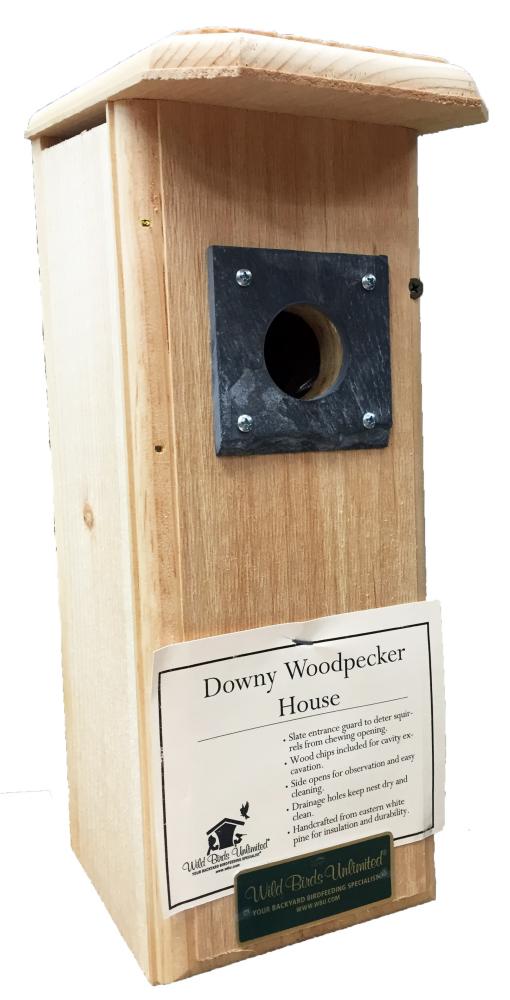 WBU Downy Woodpecker House: America's smallest woodpecker, the Downy is a backyard favourite. They are friendly little birds that enjoy being around people. Since Downy woodpeckers tend to use nest boxes in the winter as roosts to escape the cold, you may want to put up the WBU Downy Woodpecker House in the fall. Made of Eastern White Pine, this bird house is constructed to last and features ventilation and drainage holes, doors that open for easy access for cleaning, hooks for hanging and a rough interior so fledglings can easily leave the nest box. Each bird house also includes a brochure that describes the species that the nest box has been designed for, ideal placement, and maintenance of the product. This bird house also comes standard with slate squirrel guard and wood chips.
WBU Downy Woodpecker House: America's smallest woodpecker, the Downy is a backyard favourite. They are friendly little birds that enjoy being around people. Since Downy woodpeckers tend to use nest boxes in the winter as roosts to escape the cold, you may want to put up the WBU Downy Woodpecker House in the fall. Made of Eastern White Pine, this bird house is constructed to last and features ventilation and drainage holes, doors that open for easy access for cleaning, hooks for hanging and a rough interior so fledglings can easily leave the nest box. Each bird house also includes a brochure that describes the species that the nest box has been designed for, ideal placement, and maintenance of the product. This bird house also comes standard with slate squirrel guard and wood chips.
Downy Woodpeckers prefer to nest in forests or on forest edges with large trees such as parks, wooded suburbs, and yards. Downy Woodpeckers bird houses are best hung 5 to 15 feet high in a tree away. Face the entrance hole away from prevailing winds and place about 3 to 4 inches of wood shavings on the bottom of the box.
Dimensions: 15½" x 5¾" x 8"
House Opening: 1½” diameter entrance hole
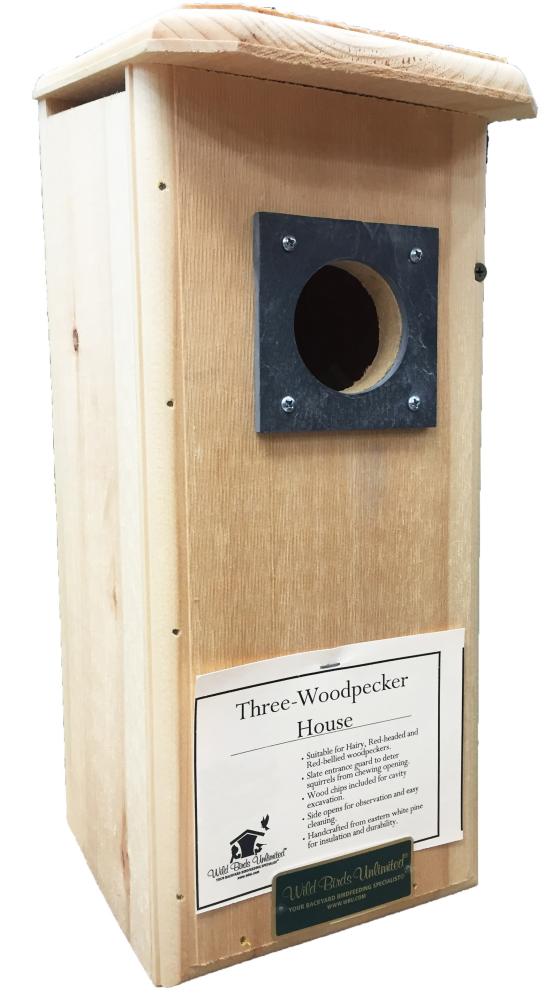 WBU Three Woodpeckers House: Only a few varieties of woodpeckers will live in a man-made box, but the Hairy, Red-headed and Red-bellied Woodpeckers regularly do so, and this nesting box can accommodate any of them. Made of Eastern White Pine, this bird house is constructed to last and features ventilation and drainage holes, doors that open for easy access for cleaning, hooks for hanging and a rough interior so fledglings can easily leave the nest box. Each bird house also includes a brochure that describes the species that the nest box has been designed for, ideal placement, and maintenance of the product. The WBU Three Woodpecker House also comes with wood chips and a slate predator guard to keep squirrels from enlarging the entrance hole.
WBU Three Woodpeckers House: Only a few varieties of woodpeckers will live in a man-made box, but the Hairy, Red-headed and Red-bellied Woodpeckers regularly do so, and this nesting box can accommodate any of them. Made of Eastern White Pine, this bird house is constructed to last and features ventilation and drainage holes, doors that open for easy access for cleaning, hooks for hanging and a rough interior so fledglings can easily leave the nest box. Each bird house also includes a brochure that describes the species that the nest box has been designed for, ideal placement, and maintenance of the product. The WBU Three Woodpecker House also comes with wood chips and a slate predator guard to keep squirrels from enlarging the entrance hole.
Hairy, Red-headed and Red-bellied Woodpeckers prefer to nest in forests or on forest edges with large trees such as parks, wooded suburbs, and yards. Hairy, Red-headed, and Red-bellied Woodpecker bird houses are best hung 8 to 20 feet high in a tree away. Face the entrance hole away from prevailing winds and place about 3 to 4 inches of wood shavings on the bottom of the box.
Dimensions: 17½" x 7½" x 9¾"
House Opening: 2¼” diameter entrance hole
Duck and Owl Houses
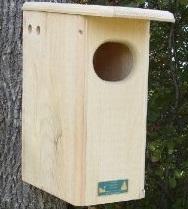 WBU Small Wood Duck House: "Dump nesting" occurs when a number of females lay eggs in a single house, which sometimes results in clutches with over 70 eggs. Mississippi State University did a study of Wood Ducks in an effort to reduce this problem. A smaller nest box was designed and "dump nesting" was reduced. Although fewer ducklings are fledged from each box, the survival rate is improved and the cost per fledgling is less. The WBU Small Wood Duck House is made of Eastern White Pine and features ventilation and drainage holes, a wire ladder, nesting chips, hooks for hanging, and the front opens for observation and cleaning. Each bird house also includes a brochure that describes the species that the nest box has been designed for, ideal placement, and maintenance of the product.
WBU Small Wood Duck House: "Dump nesting" occurs when a number of females lay eggs in a single house, which sometimes results in clutches with over 70 eggs. Mississippi State University did a study of Wood Ducks in an effort to reduce this problem. A smaller nest box was designed and "dump nesting" was reduced. Although fewer ducklings are fledged from each box, the survival rate is improved and the cost per fledgling is less. The WBU Small Wood Duck House is made of Eastern White Pine and features ventilation and drainage holes, a wire ladder, nesting chips, hooks for hanging, and the front opens for observation and cleaning. Each bird house also includes a brochure that describes the species that the nest box has been designed for, ideal placement, and maintenance of the product.
Wood Ducks prefer to nest in forests near water such as a wetland or pond. Place the WBU Small Wood Duck House near a pond or wetland on a post or tree. Wood Duck houses are best hung 6 to 30 feet high in a tree away. Face the entrance hole away from prevailing winds and place about 5 to 6 inches of wood shavings on the bottom of the box.
Dimensions: 17" x 7½" x 15"
House Opening: 4½” W x 3" H diameter entrance hole
![]() Add Me to your MyWBU Online Order - Include SKU #1249 in Your Order Notes at Checkout.
Add Me to your MyWBU Online Order - Include SKU #1249 in Your Order Notes at Checkout.
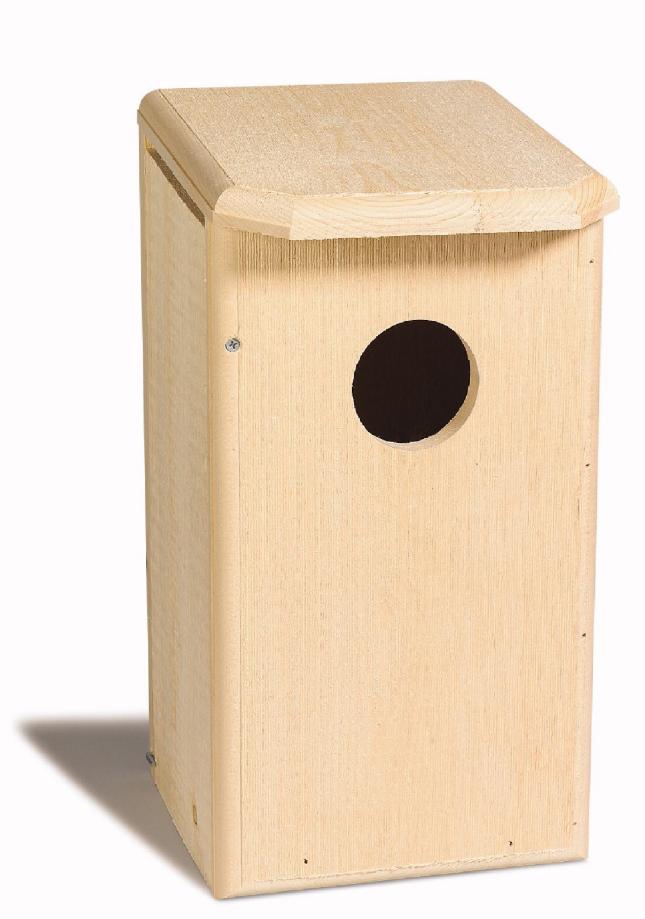 WBU Saw-Whet/Screech Owl House: Saw-whet owls and screech owls have tough competition from other birds because they are so small. The WBU Saw-Whet/Screech Owl House provides a perfect cavity, complete with wood chips for nesting material. Made of Eastern White Pine, this bird house is constructed to last and features ventilation and drainage holes, doors that open for easy access for cleaning, hooks for hanging and a rough interior so fledglings can easily leave the nest box. Each bird house also includes a brochure that describes the species that the nest box has been designed for, ideal placement, and maintenance of the product. This bird house also comes standard with slate squirrel guard and wood chips.
WBU Saw-Whet/Screech Owl House: Saw-whet owls and screech owls have tough competition from other birds because they are so small. The WBU Saw-Whet/Screech Owl House provides a perfect cavity, complete with wood chips for nesting material. Made of Eastern White Pine, this bird house is constructed to last and features ventilation and drainage holes, doors that open for easy access for cleaning, hooks for hanging and a rough interior so fledglings can easily leave the nest box. Each bird house also includes a brochure that describes the species that the nest box has been designed for, ideal placement, and maintenance of the product. This bird house also comes standard with slate squirrel guard and wood chips.
Northern Saw-Whet Owls and Eastern Screech Owls prefer to nest in forests or along the forest edge. Houses for Northern Saw-Whet Owls and Eastern Screech Owls are best hung 10 to 30 feet high in a tree. Face the entrance hole away from prevailing winds and place about 5 to 6 inches of wood shavings on the bottom of the box.
Dimensions: 17¾" x 9¼" x 11"
House Opening: 3” diameter entrance hole
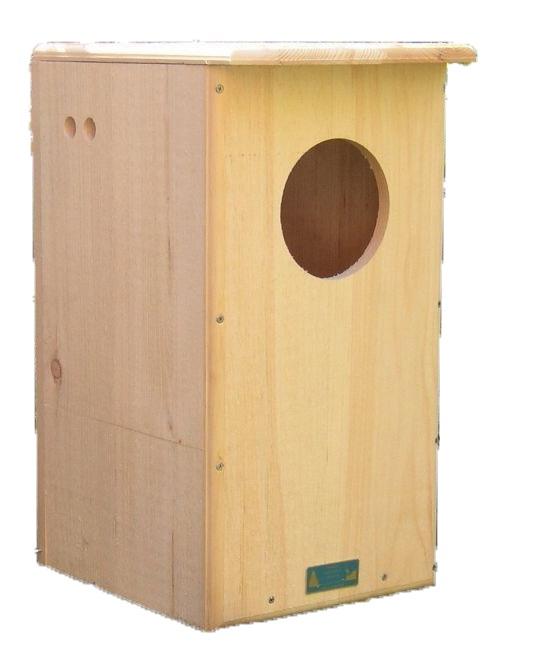 WBU Barred Owl House: The Barred Owl is a large owl who sings a “who-cooks-for-you, who-cooks-for-you-all” song. The WBU Barred Owl House is made of Eastern White Pine and features ventilation and drainage holes, doors that open on the sides for easy access for cleaning and two hooks for hanging. Each bird house also includes a brochure that describes the species that the nest box has been designed for, ideal placement, and maintenance of the product.
WBU Barred Owl House: The Barred Owl is a large owl who sings a “who-cooks-for-you, who-cooks-for-you-all” song. The WBU Barred Owl House is made of Eastern White Pine and features ventilation and drainage holes, doors that open on the sides for easy access for cleaning and two hooks for hanging. Each bird house also includes a brochure that describes the species that the nest box has been designed for, ideal placement, and maintenance of the product.
Barred Owls prefer to nest in forests or along the forest edge. Houses for Barred Owls are best hung 10 to 30 feet high in a tree. Face the entrance hole away from prevailing winds and place about 5 to 6 inches of wood shavings on the bottom of the box.
Dimensions: 25" x 14¼" x 19"
House Opening: 6½” diameter entrance hole
Nesting Shelves
 WBU Nesting Perch: Some species of birds prefer an open-front box. Song sparrows, catbirds, thrashers, phoebes, robins, and barn swallows like to raise their families in a platform nest. The WBU Nesting Perch may be placed under the eaves, inside a garage or bar, or on the side of a building. It offers protection from elements and is made from Eastern White Pine.
WBU Nesting Perch: Some species of birds prefer an open-front box. Song sparrows, catbirds, thrashers, phoebes, robins, and barn swallows like to raise their families in a platform nest. The WBU Nesting Perch may be placed under the eaves, inside a garage or bar, or on the side of a building. It offers protection from elements and is made from Eastern White Pine.
Dimensions: 9½” x 9¼" x 8 ½"
![]() Add Me to MyWBU Online Order - Include SKU #1218 in Your Order Notes at Checkout.
Add Me to MyWBU Online Order - Include SKU #1218 in Your Order Notes at Checkout.
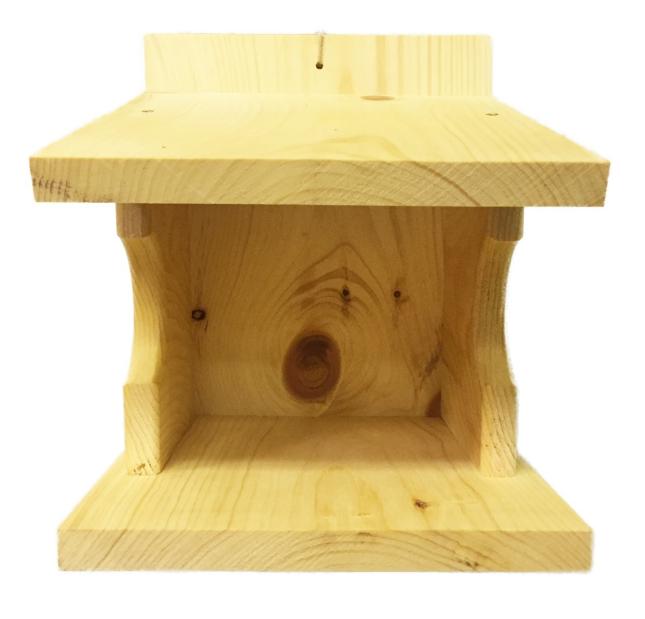 Nesting Shelf: Some species of birds prefer an open-front box. Song sparrows, catbirds, thrashers, phoebes, robins, Mourning Doves, Blue Jays, and barn swallows like to build nests on ledges and will readily raise their families in a platform nesting shelf. The Nesting Shelf may be placed under the eaves, inside a garage, or on the side of a building. It offers protection from elements and is handmade here in Ontario from white pine. This roost is ready to withstand the elements. Mount your nesting shelf between 7 and 12 feet high, on a post, tree or under the eaves of your house or shed.
Nesting Shelf: Some species of birds prefer an open-front box. Song sparrows, catbirds, thrashers, phoebes, robins, Mourning Doves, Blue Jays, and barn swallows like to build nests on ledges and will readily raise their families in a platform nesting shelf. The Nesting Shelf may be placed under the eaves, inside a garage, or on the side of a building. It offers protection from elements and is handmade here in Ontario from white pine. This roost is ready to withstand the elements. Mount your nesting shelf between 7 and 12 feet high, on a post, tree or under the eaves of your house or shed.
Dimensions: 13" H x 9" W x 10” D
![]() Add Me to MyWBU Online Order - Include SKU #430203 in Your Order Notes at Checkout.
Add Me to MyWBU Online Order - Include SKU #430203 in Your Order Notes at Checkout.
Purple Martin Houses
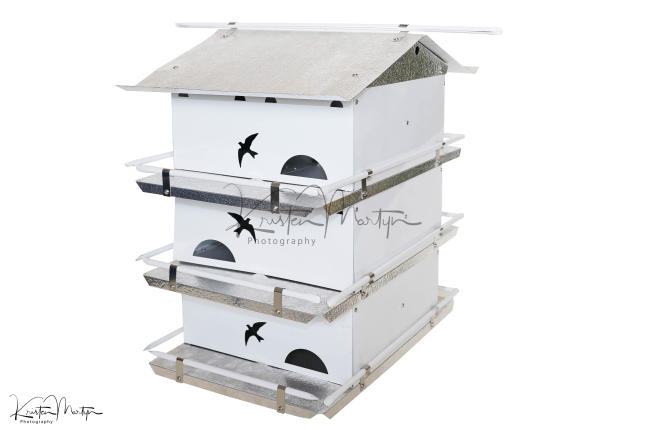 WBU Purple Martin Houses: The WBU Purple Martin Houses are some of the most scientifically proven houses available on the market today. Each 6" x 12" suite concept utilizes two compartments per family offering an entry room and a nesting room (each room is 6” x 6”). The martins enter through a starling resistant entry hole. From the entry room, they travel 90 degrees through a 2¼" opening into the nesting room with an elevated sub floor and nesting trays. This design provides greater protection from natural predators such as owls, raccoons, and hawks. The ceiling panel allows for excellent ventilation while the roof reflects light to avoid overheating. The doors of the WBU Purple Martin Houses are hinged for easy cleaning and guard rails and a top perch allows plenty of space. Martins have a tendency to yield more fledglings from large compartments and the entry room serves as a protective staging area for the young birds prior to flight Starling resistant entrance holes. These products is sold both assembled and unassembled. Purple Martins are found around the Great Lakes in Ontario as well as other larger lakes. In Simcoe County there are populations of Purple Martins on Lake Simcoe. Place the WBU Purple Martin Houses close to the water’s edge, at least 15' high, so the martins can easily find it. Add the WBU Purple Martin Houses is available in the following three sizes:
WBU Purple Martin Houses: The WBU Purple Martin Houses are some of the most scientifically proven houses available on the market today. Each 6" x 12" suite concept utilizes two compartments per family offering an entry room and a nesting room (each room is 6” x 6”). The martins enter through a starling resistant entry hole. From the entry room, they travel 90 degrees through a 2¼" opening into the nesting room with an elevated sub floor and nesting trays. This design provides greater protection from natural predators such as owls, raccoons, and hawks. The ceiling panel allows for excellent ventilation while the roof reflects light to avoid overheating. The doors of the WBU Purple Martin Houses are hinged for easy cleaning and guard rails and a top perch allows plenty of space. Martins have a tendency to yield more fledglings from large compartments and the entry room serves as a protective staging area for the young birds prior to flight Starling resistant entrance holes. These products is sold both assembled and unassembled. Purple Martins are found around the Great Lakes in Ontario as well as other larger lakes. In Simcoe County there are populations of Purple Martins on Lake Simcoe. Place the WBU Purple Martin Houses close to the water’s edge, at least 15' high, so the martins can easily find it. Add the WBU Purple Martin Houses is available in the following three sizes:
- 4 Floor/ 8 Room Suite Dimensions: 27” x 12” Available by Special Order
- 3 Floors/6 Room Suite Dimensions: 21" x 12" Available by Special Order
- 2 Floors/4 Room Suite Dimension: 15" x 12" (regularly in stock)
![]() Please contact us to inquire about Purple Martin houses.
Please contact us to inquire about Purple Martin houses.
Housing Accessories
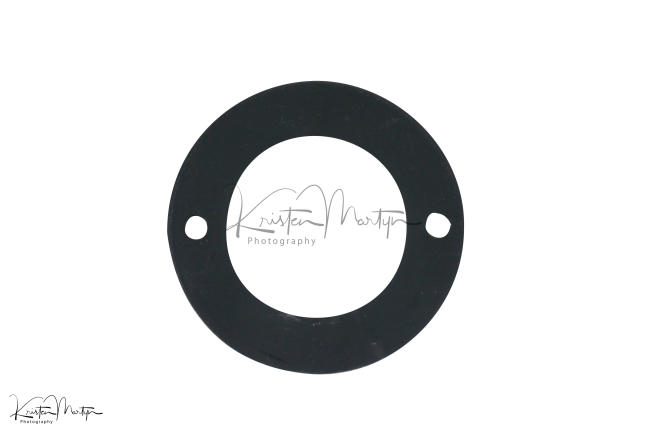 WBU Metal Predator Guards: WBU Metal Predator Guards prevent birds and other wildlife, such as squirrels and raccoons from making nest box holes larger. The metal is chew proof and protects the opening. Different size diameters are available:
WBU Metal Predator Guards: WBU Metal Predator Guards prevent birds and other wildlife, such as squirrels and raccoons from making nest box holes larger. The metal is chew proof and protects the opening. Different size diameters are available:
- 1⅛” Diameter
- 1¼” Diameter
- 1½” Diameter
![]() Add 1⅛” Diameter to your MyWBU Online Order - Include SKU #2283 in Your Order Notes at Checkout.
Add 1⅛” Diameter to your MyWBU Online Order - Include SKU #2283 in Your Order Notes at Checkout.
![]() Add 1¼” Diameter to your MyWBU Online Order - Include SKU #2284 in Your Order Notes at Checkout.
Add 1¼” Diameter to your MyWBU Online Order - Include SKU #2284 in Your Order Notes at Checkout.
![]() Add 1½” Diameter to your MyWBU Online Order - Include SKU #2285 in Your Order Notes at Checkout.
Add 1½” Diameter to your MyWBU Online Order - Include SKU #2285 in Your Order Notes at Checkout.
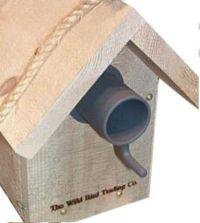 Predator Guard: Helps protect nesting boxes and bird houses from day and nighttime predators such as raccoons, cats, crows, squirrels and more. Easy to install, simply attach over the entry way and secure with the two included screws.
Predator Guard: Helps protect nesting boxes and bird houses from day and nighttime predators such as raccoons, cats, crows, squirrels and more. Easy to install, simply attach over the entry way and secure with the two included screws.
Dimensions: 1½" diameter x 2¼" deep
![]() Add Me to your MyWBU Online Order - Include SKU #431101 in Your Order Notes at Checkout.
Add Me to your MyWBU Online Order - Include SKU #431101 in Your Order Notes at Checkout.
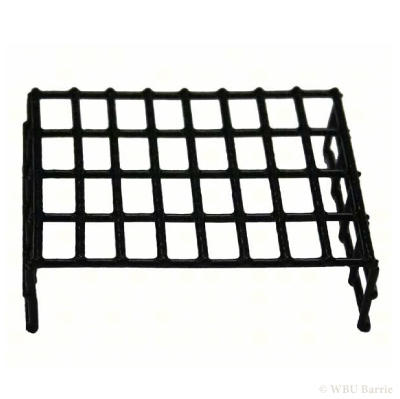 Nest Lift: Such a simple product with a huge impact. The Nest Lift keeps nests dry and safe! Simply place in bottom of bird house and the birds will nest right on top. Helps control Blow flies, parasites, and other nesting problems. Helps ensure more viable eggs hatch.
Nest Lift: Such a simple product with a huge impact. The Nest Lift keeps nests dry and safe! Simply place in bottom of bird house and the birds will nest right on top. Helps control Blow flies, parasites, and other nesting problems. Helps ensure more viable eggs hatch.
Dimensions: 4” x 4” x 1 “
![]() Add Me to your MyWBU Online Order - Include SKU #430404 in Your Order Notes at Checkout.
Add Me to your MyWBU Online Order - Include SKU #430404 in Your Order Notes at Checkout.
 WBU Wood Shavings: Our WBU Wood Shavings are made from pine trees and provide an annual replenishment of nesting material for woodpeckers, ducks, owls, and a variety of other birds that excavate their nest. Wood shavings resemble the bits of wood a bird would typically excavate from a nesting cavity. They provide a bit of bedding for the nest and also encourage birds to nest because they resemble a natural situation. Wood shavings are better than sawdust, which can mat down and retain moisture.
WBU Wood Shavings: Our WBU Wood Shavings are made from pine trees and provide an annual replenishment of nesting material for woodpeckers, ducks, owls, and a variety of other birds that excavate their nest. Wood shavings resemble the bits of wood a bird would typically excavate from a nesting cavity. They provide a bit of bedding for the nest and also encourage birds to nest because they resemble a natural situation. Wood shavings are better than sawdust, which can mat down and retain moisture.
![]() Add Me to your MyWBU Online Order - Include SKU #W10619 in Your Order Notes at Checkout.
Add Me to your MyWBU Online Order - Include SKU #W10619 in Your Order Notes at Checkout.
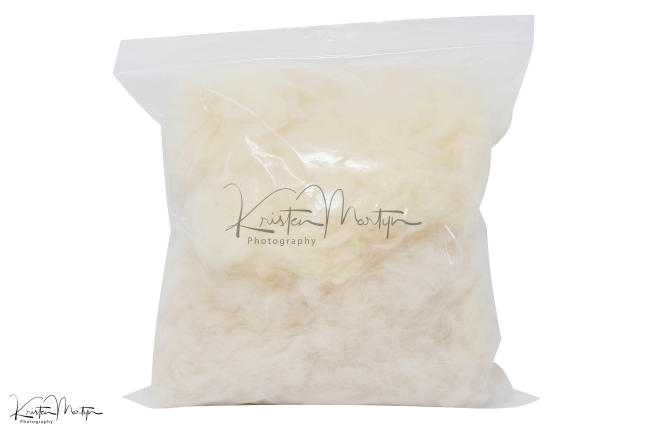 Alpaca Fleece Nesting Material: Birds often fur from a wide variety of other animals as nest-building materials. Our Alpaca Fleece Nesting Material is an easy way to offer your birds the materials they need for their home-building needs. Many birds actively seek fur as a nesting material during the breeding season as they use fur to line the inside of the nest to give their young ones a nice cozy place to grow. Alpaca fleece is an ideal fur to offer as it is soft, dense and fine. A little alpaca fleece goes a long way in building a nest. Birds including chickadees, wrens, nuthatches, goldfinches, orioles and titmice are especially fond of fur when building their nest. Simply hang it up in a using our WBU Suet Cages, WBU Peanut Ball Feeder and Birdie Bell and let your birds take what they need to create a place of their own. Also, be sure to shop through our other bird feeding supplies to complement all your bird feeding needs.
Alpaca Fleece Nesting Material: Birds often fur from a wide variety of other animals as nest-building materials. Our Alpaca Fleece Nesting Material is an easy way to offer your birds the materials they need for their home-building needs. Many birds actively seek fur as a nesting material during the breeding season as they use fur to line the inside of the nest to give their young ones a nice cozy place to grow. Alpaca fleece is an ideal fur to offer as it is soft, dense and fine. A little alpaca fleece goes a long way in building a nest. Birds including chickadees, wrens, nuthatches, goldfinches, orioles and titmice are especially fond of fur when building their nest. Simply hang it up in a using our WBU Suet Cages, WBU Peanut Ball Feeder and Birdie Bell and let your birds take what they need to create a place of their own. Also, be sure to shop through our other bird feeding supplies to complement all your bird feeding needs.
![]() Add Me to your MyWBU Online Order - Include SKU #4309 in Your Order Notes at Checkout.
Add Me to your MyWBU Online Order - Include SKU #4309 in Your Order Notes at Checkout.

